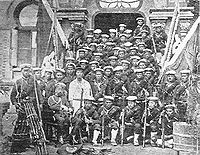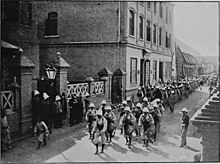EIGHT NATIONS ARMY ENTERED AND ATTACK CHINESE BOXER`S ON 14 AUGUST 1900
| Forces of the Eight-Nation Alliance Relief of the Legations  Left to right: Britain, United States, Australia,[8] India, Germany, France, Russia, Italy, Japan | |||
| Countries | Warships (units) | Marines (men) | Army (men) |
|---|---|---|---|
| 18 | 540 | 20,300 | |
| 10 | 750 | 12,400 | |
| 8 | 2,020 | 10,000 | |
| 5 | 390 | 3,130 | |
| 2 | 295 | 3,125 | |
| 5 | 600 | 300 | |
| 4 | 296 | ||
| 2 | 80 | 2500 | |
| Total | 54 | 4,971 | 49,255 |
Troops of the eight aforementioned nations invaded and occupied Peking on 14 August 1900. Empress Dowager Cixi, the Emperor and high government officials fled the Imperial Palace for Xi'an and sent Li Hongzhang for peace talks with the Alliance.
In a research article, Kenneth Clark states: "Following the taking of Peking, troops from the international force looted the capital city and even ransacked the Forbidden City, with many Chinese treasures finding their way to Europe."[24]
Atrocities[edit]
German and Japanese soldiers witnessing the street execution of a Chinese boxer.
An unknown number of people believed to be Boxers were beheaded both during and after the uprising. This became the subject of an early short film.[25]
A U.S. Marine wrote that he saw German and Russian troops bayonet women after raping them.[26]
In Peking, it was alleged that Bishop Pierre-Marie-Alphonse Favier-Duperron posted a bulletin, effective 18–26 August, declaring that Catholic Christians might steal those bare necessities required to survive, and that robbery of 50 taels of silver or fewer needed neither reporting nor compensation. The accusation was denied by the Bishop.[27]
Atrocities were also carried out by the Boxers themselves. A large number of Christians were killed before the rebellion.[28] A group of Christians that were killed before and during the rebellion are commemorated to this day as
the Holy Martyrs of China by the Orthodox,[29] and Catholic churches.[30]

British Empire[edit]
British forces, the third-largest contingent in the international alliance, were largely from India, and consisted of the following units: Naval Brigade, 12th Battery Royal Field Artillery, Hong Kong & Singapore Artillery, 2nd BattalionRoyal Welsh Fusiliers, 1st Bengal Lancers, 7th Rajput Infantry, 24th Punjab Infantry, 1st Sikh Infantry, Hong Kong Regiment, 1st Chinese Regiment, Royal Engineers, and other support personnel.[
United States[edit]
Main article: China Relief Expedition
In the United States, the suppression of the Boxer Rebellion was known as the China Relief Expedition.[20] The United States was able to play a major role in suppressing the Boxer Rebellion largely due to the presence of American forces deployed in the Philippines since the US annexation of the Philippines in 1898.[21] Of the foreign troops under siege, there were 56 American Sailors and Marines from the USS Oregon and USS Newark.[21] The main American formations deployed were the 9th Infantry and 14th Infantry regiments, elements of the 6th Cavalry regiment, the 5th Artilleryregiment, and a Marine battalion, all under the command of Adna Chaffee.
Russia[edit]
Russia supplied the second largest force after Japan, with 12,400 troops, consisting mainly of garrisons from Port Arthur and Vladivostok.
Japan[edit]
Japan provided the largest contingent of troops; 20,840, as well as 18 warships. Of the total number, 20,300 were Imperial Japanese Army troops of the 5th Infantry Division under Lt. General Yamaguchi Motoomi; the remainder were 540 naval rikusentai from the Imperial Japanese Navy
Italy[edit]
Italian forces were initially made up from sailors from warships. However, a larger contingent was later dispatched from Italy, including 83 officers, 1,882 troops, and 178 horses. The history and the vicissitudes of those eastern settlements, which remained under the Italian dominion for 41 years, involved not only the diplomatic representatives and the few Italian colonists but also the forces of the Army and the Navy. The larger part of about Italian 20,000 soldiers and officers who fought in the victorious campaign (June-August 1900) against the Boxers' rebel Chinese nationalists troops allied to the United States, Great Britain, France, Austria-Hungary, Germany, Russia and Japan - were recalled from Beijing after the end of the conflict.
Germany[edit]
Germany had gained a presence in China after the Juye Incident in which two German missionaries were murdered in November 1897. The concession in Kiaochow, with the port of Tsingtao, was used as a naval base for the East Asia Squadron and a trading port. It was governed and garrisoned by the Imperial German Navy. At the outbreak of the Boxer Rebellion in June 1900, the garrison of the German concession comprised the III. Seebataillon with 1,126 men, a marine/naval artillery battery, about 800 men of a Kommando Detachment and sailors from the East Asian Squadron.[18]
With the increasing threat of the Boxers a small group from the III. Seebatallion was sent to Peking and Tientsin to protect German interests there while the majority stayed behind to prevent attacks against Tsingtao. The siege of the foreign legations in Peking soon convinced Germany and the other European powers that more forces were needed to be sent to China to reinforce allied forces. The first troops dispatched from Germany were the Marine-Expeditionskorps which consisted of the I. and II. Seebatallions. They were soon followed by the Ostasiatische Expeditionskorps (East Asian Expeditionary Corps), which was a force of about 15,000 of mostly volunteers from the regular Army under the command of Gen Alfred Count von Waldersee. It comprised initially four and later six two-battalion infantry regiments and aJäger company, single regiments of cavalry and field artillery and various support and logistics units.[18] On arrival in China it incorporated the Marine-Expeditionskorps that had preceded it to China by a few weeks.[18]
However, the majority of the German forces dispatched arrived too late to take part in any of the major actions;[18] the first elements of the Corps arrived at Taku on September 21[18] after the legations had been relieved. As a result most of the Corps were mainly employed for garrison duties, they did fight a number of smaller engagements against pockets of remaining Boxers.[19] The Corps was later disbanded and recalled to Germany early in 1901.[19]
Australian colonies[edit]
Several of the Australian colonies sent contingents of naval and army personnel to support the British contingent. For example, South Australia sent its entire navy: the gunboat HMAS Protector.[13] Australia was not an official member of the eight-nation alliance and its forces arrived too late to see significant action.[14]
France[edit]
Indochinese French Forces were dispatched from French Indochina.







No comments:
Post a Comment